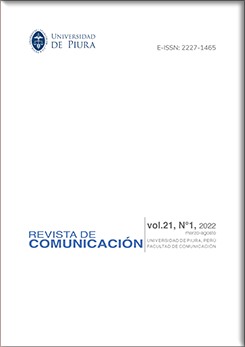Tendencias globales de investigación en neuromarketing: 2015-2020
DOI:
https://doi.org/10.26441/RC21.1-2022-A1Palabras clave:
análisis bibliométrico, PRISMA, neuromarketing, neurociencia del consumidor, Base de datos ScopusResumen
El creciente interés en el descubrimiento de los comportamientos emocionales y de los procesos cognitivos de los consumidores, en la investigación de mercados ha llevado a un número creciente de publicaciones. Este artículo evalúa las tendencias de investigación global en el dominio del neuromarketing / neurociencia del consumidor con base en las revistas científicas más productivas, los países, las instituciones, los autores, y el número de documentos y citas. La estructura de este artículo está basado en el sistema Preferred Reporting Items for Systematic Reviews and Meta-Analyses (PRISMA) y selecciona todos los documentos relevantes para este estudio bibliométrico. Se han extraído y analizado un total de 119 documentos de la base de datos Scopus. Los hallazgos revelaron que España es el país líder en este campo de investigación con 21 publicaciones, y la institución más productiva fue la Universidad Complutense de Madrid, con siete documentos. Además, Ma, Q. es el autor más prolífico con cuatro publicaciones y 11 citas. Curiosamente, aunque Frontiers in Psychology es la revista más productiva con 11 publicaciones, la revista Comunicar tiene el promedio más alto de citas por ítem. El análisis de palabras clave y citas es muy significativo para conocer los documentos y palabras más impactantes en neuromarketing. Por ejemplo, EEG (18 apariciones y 43 fuerza de enlace total) significa la ocurrencia de EEG 22 veces, y la fuerza de vínculo total para estas apariciones son 43 vínculos con el tema del neuromarketing. Chew L.H. et al., ha publicado el documento más citado con 27 citas.
Métricas
Citas
Abbas, A. F., bin Jusoh, A., Mas' od, A., & Mor, K. M. (2020a). Market maven and mavenism: A bibliometrics analysis using Scopus database. International Journal of Management, 11(11), 31-45. https://doi.org/10.34218/IJM.11.11.2020.004
Abbas, A. F., Jusoh, A., Mas’od, A., & Ali, J. (2020b). Bibliometric analysis of global research trends on electronic word of mouth using Scopus database. Journal of Critical Reviews, 7(16), 405-412. https://doi.org/10.31838/jcr.07.16.49
Ali, J., Jusoh, A., Abbas, A. F., & Nor, K. M. (2021a). Global trends of service quality in healthcare: A bibliometric analysis of scopus database. Journal of Contemporary Issues in Business and Government, 27(1), 2917-2930.
Ali, J., Jusoh, A., Idris, N., Abbas, A. F., & Alsharif, A. H. (2021b). Everything is Going Electronic, so do Services and Service Quality: Bibliometric Analysis of E-Services and E-Service Quality. International Journal of Interactive Mobile Technologies, 15(18), 148-166. https://doi.org/10.3991/ijim.v15i18.24519 DOI: https://doi.org/10.3991/ijim.v15i18.24519
Ali, J., Jusoh, A., Idris, N., Abbas, A. F., & Alsharif, A. H. (2021c). Nine Years of Mobile Healthcare Research: A Bibliometric Analysis. International Journal of Online & Biomedical Engineering, 17(10). https://doi.org/10.3991/ijoe.v17i10.25243 DOI: https://doi.org/10.3991/ijoe.v17i10.25243
Alsharif, A. H., Salleh, N. Z. M., & Baharun, R. (2020a). Research trends of neuromarketing: A bibliometric analysis. Journal of Theoretical and Applied Information Technology, 98(15), 2948-2962.
Alsharif, A. H., Salleh, N. Z. M., & Baharun, R. (2021a). Neuromarketing: Marketing research in the new millennium. Neuroscience Research Notes, 4(3), 27-35. https://doi.org/10.31117/neuroscirn.v4i3.79 DOI: https://doi.org/10.31117/neuroscirn.v4i3.79
Alsharif, A. H., Salleh, N. Z. M., & Baharun, R. (2021b). Neuromarketing: The popularity of the brain-imaging and physiological tools. Neuroscience Research Notes, 3(5), 13-22. https://doi.org/10.31117/neuroscirn.v3i5.80 DOI: https://doi.org/10.31117/neuroscirn.v3i5.80
Alsharif, A. H., Salleh, N. Z. M., & Baharun, R. (2021c). To better understand the role of emotional processes in decision-making. International Journal of Academic Research in Economics and Management Sciences, 10(2), 49-67. https://doi.org/10.6007/ijarems/v10-i2/9883 DOI: https://doi.org/10.6007/IJAREMS/v10-i2/9883
Alsharif, A. H., Salleh, N. Z. M., Baharun, R., & Alharthi, R. H. E. (2021d). Neuromarketing research in the last five years: a bibliometric analysis. Cogent Business & Management, 8(1), 1978620. https://doi.org/10.1080/23311975.2021.1978620 DOI: https://doi.org/10.1080/23311975.2021.1978620
Alsharif, A. H., Salleh, N. Z. M., Baharun, R., & Mehdi, S. (2020b). Neuromarketing approach: An overview and future research directions. Journal of Theoretical and Applied Information Technology, 98(7), 991-1001.
Alsharif, A. H., Salleh, N. Z. M., Baharun, R., Rami Hashem E., A., Mansor, A. A., Ali, J., & Abbas, A. F. (2021e). Neuroimaging techniques in advertising research: Main applications, development, and brain regions and processes. Sustainability, 13(11), 6488-6513. https://doi.org/10.3390/su13116488 DOI: https://doi.org/10.3390/su13116488
Alsharif, A. H., Salleh, N. Z. M., & Baharun, R. (2021f). A Bibliometric Analysis of Neuromarketing: Current Status, Development and Future Directions. International Journal of Academic Research in Accounting, Finance and Management Business Sciences, 11(3), 828-847. http://dx.doi.org/10.6007/IJARAFMS/v11-i3/11673 DOI: https://doi.org/10.6007/IJARAFMS/v11-i3/11292
Ananos, E. (2015). Eye tracker technology in elderly people: How integrated television content is paid attention to and processed. Comunicar, 23(45), 75-83. https://doi.org/10.3916/c45-2015-08 DOI: https://doi.org/10.3916/C45-2015-08
Avinash, T., Dikshant, L., & Seema, S. (2018). Methods of neuromarketing and implication of the frontal theta asymmetry induced due to musical stimulus as choice modeling. Procedia Computer Science, 132(2018), 55-67. https://doi.org/10.1016/j.procs.2018.05.059 DOI: https://doi.org/10.1016/j.procs.2018.05.059
Baker, H. K., Pandey, N., Kumar, S., & Haldar, A. (2020). A bibliometric analysis of board diversity: Current status, development, and future research directions. Journal of Business Research, 108(2020), 232-246. https://doi.org/10.1016/j.jbusres.2019.11.025 DOI: https://doi.org/10.1016/j.jbusres.2019.11.025
Baraybar-Fernández, A., Baños-González, M., Barquero-Pérez, Ó., Goya-Esteban, R., & De-la-Morena-Gómez, A. (2017). Evaluation of emotional responses to television advertising through neuromarketing. Comunicar, 25(52), 19-28. https://doi.org/10.3916/c52-2017-02 DOI: https://doi.org/10.3916/C52-2017-02
Block, J. H., & Fisch, C. (2020). Eight tips and questions for your bibliographic study in business and management research. Management Review Quarterly, 70(3), 307-312. https://doi.org/10.1007/s11301-020-00188-4 DOI: https://doi.org/10.1007/s11301-020-00188-4
Bosshard, S. S., Bourke, J. D., Kunaharan, S., Koller, M., & Walla, P. (2016). Established liked versus disliked brands: Brain activity, implicit associations and explicit responses. Cogent Psychology, 3(1), 1-16. https://doi.org/10.1080/23311908.2016.1176691 DOI: https://doi.org/10.1080/23311908.2016.1176691
Breiter, H. C., Block, M., Blood, A. J., Calder, B., Chamberlain, L., Lee, N., . . . Schultz, D. (2015). Redefining neuromarketing as an integrated science of influence. Frontiers in Human Neuroscience, 8(2), 1-7. https://doi.org/10.3389/fnhum.2014.01073 DOI: https://doi.org/10.3389/fnhum.2014.01073
Cartocci, G., Caratù, M., Modica, E., Maglione, A. G., Rossi, D., Cherubino, P., & Babiloni, F. (2017). Electroencephalographic, heart rate, and galvanic skin response assessment for an advertising perception study: Application to antismoking public service announcements. Journal of Visualized Experiments, 3(126), 55872-55881. https://doi.org/10.3791/55872 DOI: https://doi.org/10.3791/55872
Cherubino, P., Martinez-Levy, A. C., Caratu, M., Cartocci, G., Di Flumeri, G., Modica, E., . . . Trettel, A. (2019). Consumer behaviour through the eyes of neurophysiological measures: State of the art and future trends. Computational Intelligence and Neuroscience, 3(2), 01-41. https://doi.org/10.1155/2019/1976847 DOI: https://doi.org/10.1155/2019/1976847
Chew, L. H., Teo, J., & Mountstephens, J. (2016). Aesthetic preference recognition of 3D shapes using EEG. Cognitive neurodynamics, 10(2), 165-173. https://doi.org/10.1007/s11571-015-9363-z DOI: https://doi.org/10.1007/s11571-015-9363-z
Comerio, N., & Strozzi, F. (2019). Tourism and its economic impact: A literature review using bibliometric tools. Tourism economics, 25(4), 109-131. https://doi.org/10.1177/1354816618793762 DOI: https://doi.org/10.1177/1354816618793762
Constantinescu, M., Orindaru, A., Pachitanu, A., Rosca, L., Caescu, S.-C., & Orzan, M. C. (2019). Attitude evaluation on using the neuromarketing approach in social media: Matching company’s purposes and consumer’s benefits for sustainable business growth. Sustainability, 11(24), 7094. https://doi.org/10.3390/su11247094 DOI: https://doi.org/10.3390/su11247094
Cuesta-Cambra, U., Niño-González, J.-I., & Rodríguez-Terceño, J. (2017). The cognitive processing of an educational app with EEG and eye tracking. Media Education Research Journal, 25(52), 41-50. https://doi.org/10.3916/c52-2017-04 DOI: https://doi.org/10.3916/C52-2017-04
Goto, N., Mushtaq, F., Shee, D., Lim, X. L., Mortazavi, M., Watabe, M., & Schaefer, A. (2017). Neural signals of selective attention are modulated by subjective preferences and buying decisions in a virtual shopping task. Biological psychology, 128(2017), 11-20. https://doi.org/10.1016/j.biopsycho.2017.06.004 DOI: https://doi.org/10.1016/j.biopsycho.2017.06.004
Guixeres, J., Bigné, E., Ausín Azofra, J. M., Alcañiz Raya, M., Colomer Granero, A., Fuentes Hurtado, F., & Naranjo Ornedo, V. (2017). Consumer neuroscience-based metrics predict recall, liking and viewing rates in online advertising. Frontiers in Psychology, 8(3), 1808. https://doi.org/10.3389/fpsyg.2017.01808 DOI: https://doi.org/10.3389/fpsyg.2017.01808
Harris, J., Ciorciari, J., & Gountas, J. (2018). Consumer neuroscience for marketing researchers. Journal of Consumer Behaviour, 17(3), 239-252. https://doi.org/10.1002/cb.1710 DOI: https://doi.org/10.1002/cb.1710
Harris, J., Ciorciari, J., & Gountas, J. (2019). Consumer neuroscience and digital/social media health/social cause advertisement effectiveness. Behavioral Sciences, 9(4), 25. https://doi.org/10.3390/bs9040042 DOI: https://doi.org/10.3390/bs9040042
Iloka, B. C., & Onyeke, K. J. (2020). Neuromarketing: a historical review. Neuroscience Research Notes, 3(3), 27-35. https://doi.org/10.31117/neuroscirn.v3i3.54 DOI: https://doi.org/10.31117/neuroscirn.v3i3.54
Isabella, G., Mazzon, J. A., & Dimoka, A. (2015). Culture differences, difficulties, and challenges of the neurophysiological methods in marketing research. Journal of International Consumer Marketing, 27(5), 346-363. https://doi.org/10.1080/08961530.2015.1038761 DOI: https://doi.org/10.1080/08961530.2015.1038761
Khudzari, J. M., Kurian, J., Tartakovsky, B., & Raghavan, G. V. (2018). Bibliometric analysis of global research trends on microbial fuel cells using Scopus database. Biochemical engineering journal, 136(2018), 51-60. https://doi.org/10.1016/j.bej.2018.05.002 DOI: https://doi.org/10.1016/j.bej.2018.05.002
Kumar, S., Sureka, R., & Colombage, S. (2019). Capital structure of SMEs: A systematic literature review and bibliometric analysis. Management Review Quarterly, 4(2), 1-31. https://doi.org/10.1007/s11301-019-00175-4 DOI: https://doi.org/10.1007/s11301-019-00175-4
Lee, N., Chamberlain, L., & Brandes, L. (2018). Welcome to the jungle! The neuromarketing literature through the eyes of a newcomer. European Journal of Marketing, 52(1-2), 4-38. https://doi.org/10.1108/ejm-02-2017-0122 DOI: https://doi.org/10.1108/EJM-02-2017-0122
McClure, S. M., Li, J., Tomlin, D., Cypert, K. S., Montague, L. M., & Montague, P. R. (2004). Neural correlates of behavioral preference for culturally familiar drinks. Neuron, 44(2), 379-387. https://doi.org/10.1016/j.neuron.2004.09.019 DOI: https://doi.org/10.1016/j.neuron.2004.09.019
Minguillon, J., Lopez-Gordo, M. A., Renedo-Criado, D. A., Sanchez-Carrion, M. J., & Pelayo, F. (2017). Blue lighting accelerates post-stress relaxation: Results of a preliminary study. PloS one, 12(10), e0186399. https://doi.org/10.1371/journal.pone.0186399 DOI: https://doi.org/10.1371/journal.pone.0186399
Moher, D., Shamseer, L., Clarke, M., Ghersi, D., Liberati, A., Petticrew, M., . . . Stewart, L. A. (2015). Preferred reporting items for systematic review and meta-analysis protocols (PRISMA-P) 2015 statement. Systematic reviews, 4(1), 1-9. https://doi.org/10.1186/2046-4053-4-1 DOI: https://doi.org/10.1186/2046-4053-4-1
Ramsoy, T. Z., Skov, M., Christensen, M. K., & Stahlhut, C. (2018). Frontal Brain Asymmetry and Willingness to Pay. Frontiers in Neuroscience, 12(3), 138-150. https://doi.org/10.3389/fnins.2018.00138 DOI: https://doi.org/10.3389/fnins.2018.00138
Ravikumar, S., Agrahari, A., & Singh, S. N. (2015). Mapping the intellectual structure of scientometrics: A co-word analysis of the journal Scientometrics (2005–2010). Scientometrics, 102(1), 929-955. DOI: https://doi.org/10.1007/s11192-014-1402-8
Sánchez-Fernández, J., Casado-Aranda, L.-A., & Bastidas-Manzano, A.-B. (2021). Consumer Neuroscience Techniques in Advertising Research: A Bibliometric Citation Analysis. Sustainability, 13(3), 1589. https://doi.org/10.3390/su13031589 DOI: https://doi.org/10.3390/su13031589
Sebastian, V. (2014). New directions in understanding the decision-making process: neuroeconomics and neuromarketing. In M. Chraif, C. Vasile, & M. Anitei (Eds.), International Conference Psychology and the Realities of the Contemporary World (Vol. 127, pp. 758-762). Amsterdam. Elsevier Science Bv. https://doi.org/10.1016/j.sbspro.2014.03.350 DOI: https://doi.org/10.1016/j.sbspro.2014.03.350
Smidts, A. (2002). Kijken in het brein: Over de mogelijkheden van neuromarketing. Netherland. Erasmus Research Institute of Management.
Spence, C. (2019). Neuroscience-inspired design: From academic neuromarketing to commercially relevant research. Organizational Research Methods, 22(1), 275-298. https://doi.org/10.1177/1094428116672003 DOI: https://doi.org/10.1177/1094428116672003
Stanton, S., Armstrong, W., & Huettel, S. (2017). Neuromarketing: Ethical implications of its use and potential misuse. Journal of Business Ethics, 144(4), 799-811. DOI:https://doi.org/10.1007/s10551-016-3059-0 DOI: https://doi.org/10.1007/s10551-016-3059-0
Van Eck, N., & Waltman, L. (2013). Manual for VOSviewer version 1.5. 4. Universiteit Leiden and Erasmus Universiteit Rotterdam, 1(1), 1-53.
Venkatraman, V., Dimoka, A., Pavlou, P. A., Vo, K., Hampton, W., Bollinger, B., . . . Winer, R. S. (2015). Predicting advertising success beyond traditional measures: New insights from neurophysiological methods and market response modeling. Journal of Marketing Research, 52(4), 436-452. https://doi.org/10.2139/ssrn.2498095 DOI: https://doi.org/10.1509/jmr.13.0593
Wang, M., & Chai, L. (2018). Three new bibliometric indicators/approaches derived from keyword analysis. Scientometrics, 116(3), 721-750. https://doi.org/10.1007/s11192-018-2768-9 DOI: https://doi.org/10.1007/s11192-018-2768-9
Wang, R. W., Chang, Y.-C., & Chuang, S.-W. (2016). EEG spectral dynamics of video commercials: impact of the narrative on the branding product preference. Scientific Reports, 6(1), 36487-36498. https://doi.org/10.1038/srep36487 DOI: https://doi.org/10.1038/srep36487
Descargas
Publicado
Cómo citar
Número
Sección
Licencia
Derechos de autor 2022 Revista de Comunicación

Esta obra está bajo una licencia internacional Creative Commons Atribución-NoComercial-SinDerivadas 4.0.











 Portal de Revistas de la Universidad de Piura.
Portal de Revistas de la Universidad de Piura.